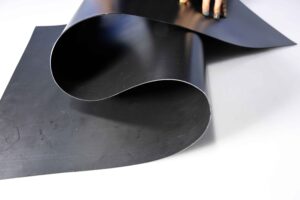HDPE geomembrane is a kind of soil anti-seepage material made of high density polyethylene (High Density Polyethylene, referred to as HDPE).
It has excellent physical properties and chemical stability, and is a functional material commonly used in civil engineering.
HDPE geomembrane is widely used in water conservancy, transportation, environmental protection, construction and other fields, for anti-seepage, isolation, reinforcement and protection projects.
Its main applications include dams, channels, landfills, artificial lakes, sewage treatment plants and road base projects.

What are the characteristics of HDPE geomembrane?
High strength: HDPE geomembrane has high tensile strength and tear strength, which can effectively resist the pulling and damage of soil.
Good weather resistance: HDPE geomembrane has good weather resistance, can maintain its physical properties for a long time, and can exert excellent performance under different climatic conditions.
Good chemical resistance: HDPE geomembrane has good resistance to most acids, alkalis, salts and other chemical substances, and is not easy to be chemically corroded.
Good water permeability: HDPE geomembrane can effectively prevent water penetration and play a role in water and soil conservation.
Good anti-seepage effect: HDPE geomembrane has a good anti-seepage function, which can effectively prevent the infiltration of surface water, groundwater and liquid, and provide anti-seepage effect.
Long service life: HDPE geomembrane has a long service life and can maintain stable performance for a long time under harsh environmental conditions.

What are the installation methods of hdpe geomembrane?
HDPE (High Density Polyethylene) Geomembrane is a material used for anti-penetration and protection, and is often used in water conservancy, environmental engineering, road engineering and other fields. It can be installed in the following ways:
Surface installation: Lay the HDPE geomembrane on the surface of the substrate, use clamps or soft boards to fix the edges, and ensure that there are no local funnels, bubbles or curls between the membrane and the substrate.
Cylindrical laying: suitable for surfaces requiring protection such as embankments or slopes. The prefabricated HDPE geomembrane roll is cut to a suitable size, and the membrane is covered on the cylinder with nails or other fixing methods.
Splicing and installation of short platforms: Use hook claws or electrothermal welding machines to connect two pieces of HDPE geomembrane to form a short platform, and then splice and connect this short platform with other platforms.
Pipe sleeve installation: Cut the HDPE geomembrane to a suitable size, and fix it on the pipe with a pipe sleeve to provide anti-penetration and protection effects.
Author

Founded in 2002, Tinhy's team focuses on the manufacturing, marketing, installation, application and research and development of geosynthetic materials.
View all posts





